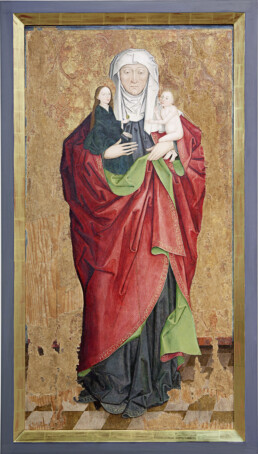Shaping Faith – Fashioning Splendour. Glauben formen – Pracht gestalten
Fashion is anything but surface, not even in medieval art. The biblical persons and saints depicted in medieval sacred art wear splendid robes, extravagant shoes, fancy headgear and precious jewellery. Textiles of all kinds characterise the paintings. Plant patterns are set into gold backgrounds using elaborate techniques, pressed brocades create 3D effects, coloured varnishes create depth effects and shadows.
A new presentation at the Diözesanmuseum Rottenburg focuses attention on the materiality of his works of art and asks about the textile messages of the medieval paintings. These were not only intended to please the eye, but also to tell of the grace-theological distinction of their wearers, to establish references to Jesus Christ and Mary through textiles or to recall biographical details. Clothes are speaking in this sense – and that is the focus.
But the exhibition does not stop at the Middle Ages. It also asks about fashion today. To what extent does it also use materiality to refer to the immaterial? Eight students of the fashion course at the Pforzheim University of Applied Sciences have been inspired by the artworks of the Diözesanmuseum and have created modern collections from this confrontation. Two designs each are on display in the museum. Their development process is documented in an “atelier” in the special exhibition room. The collections and their development process show: Even today, fashion is anything but superficial.
Finally, with the help of the CLO3D software, another course of the Pforzheim fashion course has considered what liturgical vestments might look like in the year 2121. The visionary designs are on display in the museum’s treasury.
An extensive accompanying programme explores the theme of fashion in the Middle Ages and in modern times.







